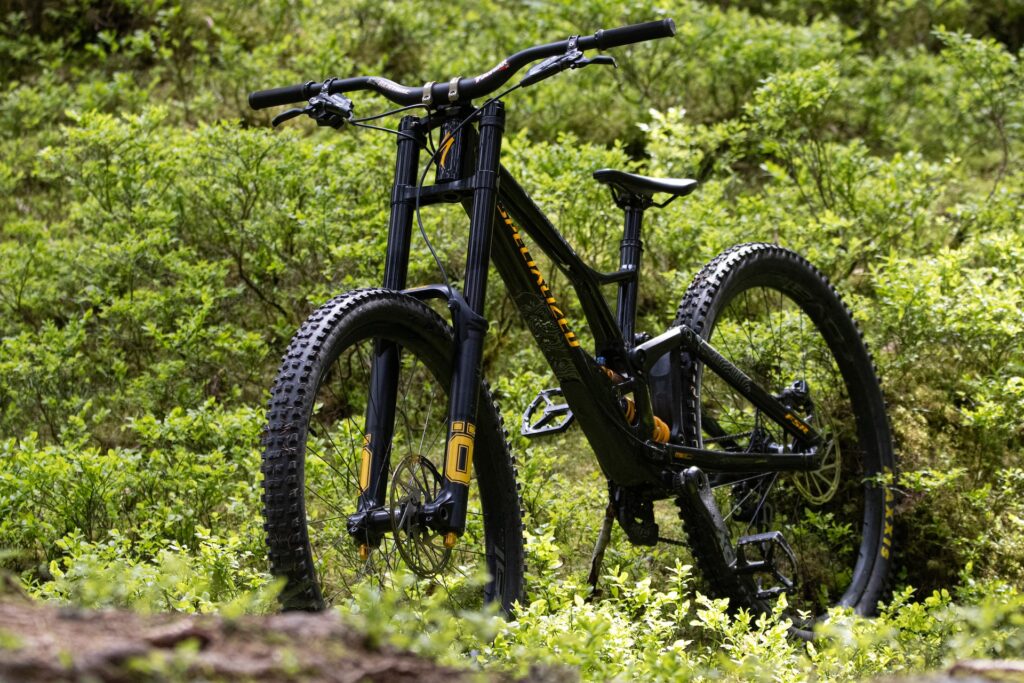Intro
Are you a mountain biking enthusiast looking to upgrade your bike’s fork? Look no further! In this ultimate guide, we will dive deep into all about mountain bike forks, discussing their different types, features, and materials. We will also explore the top brands in the market and help you determine which one is the best for your riding style and preferences. So, get ready to say “Fork Yeah!” as we break down everything you need to know about mountain bike forks.
The Anatomy of a Mountain Bike Fork

The anatomy of a mountain bike fork is a complex system that plays a crucial role in the overall performance and ride quality of your bike. Understanding its different components and how they work together is essential for any mountain biking enthusiast.
At its core, a mountain bike fork is designed to absorb impacts and vibrations from the terrain, providing a smooth and controlled ride. The most important part of a fork is the suspension system, which consists of a set of springs and dampers that help absorb the shocks and bumps encountered on the trail.
There are two main types of suspension systems used in mountain bike forks: air and coil. Air forks use compressed air to provide the desired level of suspension, while coil forks use metal springs. Each type has its advantages and disadvantages, and the choice depends on your personal preferences and riding style.
Another important component of a mountain bike fork is the stanchions. These are the large tubes that slide up and down within the fork legs, allowing the suspension to move. Stanchions are typically made of lightweight and durable materials like aluminum or carbon fiber, and they come in different diameters to accommodate different types of riding.
The fork legs, or lowers, house the stanchions and provide support for the entire fork. They also contain the bushings and seals that keep the suspension system working smoothly. The lowers are usually made of aluminum or magnesium alloy to provide a balance between strength and weight.
The steerer tube is the part of the fork that connects to the frame of the bike and allows the rider to steer. It can be either tapered or straight, depending on the design of the bike frame. Tapered steerer tubes offer increased stiffness and control, while straight steerer tubes are lighter and more cost-effective.
Finally, the crown is the piece that connects the fork legs to the steerer tube. It is usually made of aluminum or carbon fiber and provides stability and rigidity to the overall fork structure.
Types of Mountain Bike Forks

When it comes to mountain biking, having the right fork is crucial. The fork is responsible for absorbing the impact and vibrations from the trail, ensuring a smooth and controlled ride. But with so many options out there, it can be overwhelming to choose the right one for your needs. That’s why in this section, we’ll explore the different types of mountain bike forks to help you make an informed decision.
One of the most popular types of mountain bike forks is the suspension fork. This fork uses a system of springs and dampers to absorb shocks and bumps, providing a more comfortable ride. Suspension forks are available in both air and coil variants. Air forks use compressed air to provide suspension, while coil forks use metal springs. The choice between the two comes down to personal preference and riding style. Air forks are known for their adjustability and lightweight, while coil forks offer a more plush and consistent feel.
Another type of mountain bike fork is the rigid fork. As the name suggests, these forks do not have any suspension and are solid throughout. Rigid forks are often found on entry-level mountain bikes or used for specific riding disciplines like cross-country racing. They offer a lightweight and efficient ride, but they lack the comfort and control of suspension forks.
There are also hybrid forks that combine the benefits of both suspension and rigid forks. These forks have a small amount of suspension travel, typically between 60-80mm. They are ideal for riders who want a bit of comfort and control without sacrificing efficiency.
Now, let’s talk about the major players in the mountain bike fork market. Fox and RockShox are two of the most renowned brands when it comes to mountain bike forks. Fox forks are known for their precision engineering, lightweight construction, and exceptional performance. They offer a wide range of forks to cater to different riding styles and preferences. On the other hand, RockShox forks are highly regarded for their innovative technology, reliable performance, and excellent value for money. They have a reputation for providing forks that deliver a smooth and controlled ride in all conditions.
Bike Forks Suspension Travel: How Much Do You Need?

Suspension travel is a critical factor to consider when choosing a mountain bike fork. It determines how much the fork can compress and extend to absorb impacts from the trail. The right amount of suspension travel can greatly enhance your riding experience, providing a smooth and controlled ride.
When it comes to suspension travel, it’s important to find the right balance for your riding style and the type of terrain you’ll be tackling. Too little suspension travel and you risk feeling every bump and rock on the trail, leading to a rough and uncomfortable ride. On the other hand, too much suspension travel can result in decreased pedaling efficiency and sluggish handling.
The amount of suspension travel you need depends on the type of mountain biking you do. If you’re a cross-country rider who enjoys covering long distances and climbing steep hills, a fork with shorter travel, typically around 100-120mm, would be suitable. These forks prioritize pedaling efficiency and lightweight construction, making them ideal for endurance rides.
For trail riders who tackle a variety of terrain, including technical descents and jumps, a fork with medium travel, ranging from 120-160mm, is recommended. This range provides a good balance between comfort, control, and handling, allowing you to navigate through rough terrain with confidence.
If you’re an aggressive rider who loves hitting big jumps, drops, and downhill sections, a fork with longer travel, typically 160mm and above, is the way to go. These forks excel at absorbing big hits and providing maximum control and stability at high speeds.
It’s worth noting that different brands and models of mountain bike forks may have varying characteristics and performance even with the same amount of suspension travel. For example, RockShox forks are known for their plush and consistent feel, while Fox forks are recognized for their precision engineering and lightweight construction. So, consider the specific features and reputation of different fork models within the range of suspension travel that suits your riding style.
In summary, the amount of suspension travel you need depends on your riding style and the type of terrain you ride. Cross-country riders can opt for shorter travel forks, while trail riders benefit from medium travel forks. Aggressive riders should consider forks with longer travel. It’s also important to consider the specific characteristics and reputation of different fork models within your desired range of suspension travel, such as the renowned RockShox and Fox forks. By finding the right suspension travel for your needs, you can enhance your mountain biking experience and conquer any trail with confidence.
Air vs. Coil Bike Forks: Which is Best?

When it comes to choosing between air and coil suspension for your mountain bike fork, it all comes down to personal preference and riding style. Both types have their advantages and disadvantages, so let’s dive into the details and help you make an informed decision.
Air forks are known for their adjustability and lightweight construction. They use compressed air to provide suspension, allowing you to fine-tune the level of suspension to match your specific riding needs. With air forks, you can easily adjust the fork’s responsiveness and sag to optimize performance. They also tend to be lighter than coil forks, which can make a noticeable difference in overall bike weight.
On the other hand, coil forks offer a more plush and consistent feel. They use metal springs to provide suspension, and this can result in a smoother and more controlled ride. Coil forks are often favored by riders who prioritize comfort and traction over weight savings. They are known for their ability to absorb big hits and provide a solid feel on rough terrain. Additionally, coil forks require less maintenance compared to air forks, as they have fewer moving parts.
When deciding between air and coil suspension, it’s important to consider your riding style and the type of terrain you’ll be tackling. If you’re an aggressive rider who loves hitting big jumps and rough descents, a coil fork may be the better option. The consistent feel and ability to absorb big impacts can greatly enhance your riding experience and give you more confidence on the trail.
However, if you’re a cross-country rider or weight-conscious rider who values pedaling efficiency and lightweight construction, an air fork might be the better choice. The adjustability and lighter weight can help you maximize your performance and make those long climbs a little easier.
Which Brands of Bike Forks are Leading the Pack?
When it comes to mountain bike forks, there are a few brands that have stood out as leaders in the industry. These brands have consistently produced high-quality forks that have become the go-to choice for many mountain biking enthusiasts. Let’s take a closer look at the top brands that are leading the pack in the world of mountain bike forks.
One of the most well-known and respected brands in the industry is Fox. Fox has been producing top-of-the-line mtb forks for decades and has built a reputation for precision engineering, lightweight construction, and exceptional performance. Their forks are known for their plush and controlled feel, allowing riders to tackle any trail with confidence. Whether you’re an aggressive rider hitting big jumps or a cross-country rider looking for a lightweight and efficient fork, Fox has a range of options to suit your needs.
Another brand that has made a significant impact in the mountain bike fork market is RockShox. RockShox is known for its innovative technology, reliable performance, and excellent value for money. Their forks offer a smooth and controlled ride in all conditions, making them a popular choice among riders of all levels. Whether you’re a trail rider looking for comfort and control or an aggressive rider seeking maximum stability, RockShox has a fork that will meet your needs.
These two brands, Fox and RockShox, are often considered the top contenders when it comes to mountain bike forks. They both offer a wide range of forks with varying features and specifications to cater to different riding styles and preferences. Whether you’re looking for an air fork or a coil fork, Fox and RockShox have options for you.
Fox vs. RockShox: A Head to Head Comparison
When it comes to choosing between Fox and RockShox forks, mountain bikers are often faced with a tough decision. Both brands have established themselves as leaders in the industry, offering high-quality options for all types of riders. In this section, we will compare the two brands head to head and help you make an informed decision on which one is best for you.
Fox and RockShox both offer a wide range of mtb forks, catering to different riding styles and preferences. Fox forks are known for their precision engineering, lightweight construction, and exceptional performance. Their forks provide a plush and controlled feel, allowing riders to tackle any trail with confidence. On the other hand, RockShox forks are highly regarded for their innovative technology, reliable performance, and excellent value for money. They offer a smooth and controlled ride in all conditions, making them a popular choice among riders of all levels.
In terms of types of forks, both brands offer air and coil variants. Fox air forks are known for their adjustability and lightweight construction, allowing riders to fine-tune the level of suspension to match their specific needs. On the other hand, RockShox air forks provide a plush and consistent feel, with reliable performance and easy maintenance. When it comes to coil forks, both brands excel at absorbing big hits and providing maximum control and stability. It all comes down to personal preference and riding style when choosing between air and coil.
Another factor to consider is the reputation of the brands. Both Fox and RockShox have been in the industry for many years and have a loyal following of riders. Their forks have been tested and proven in various riding conditions, making them trusted choices for many mountain bikers. It’s always a good idea to do some research and read reviews from fellow riders to get an idea of their experiences with specific fork models.
Ultimately, the choice between Fox and RockShox forks comes down to your personal preferences, riding style, and budget. Both brands offer high-quality options that can enhance your mountain biking experience. Whether you’re an aggressive rider hitting big jumps or a cross-country rider looking for a lightweight and efficient fork, Fox and RockShox have options for you. Take the time to compare the features and specifications of different fork models from each brand to find the one that best suits your needs. Happy riding!




